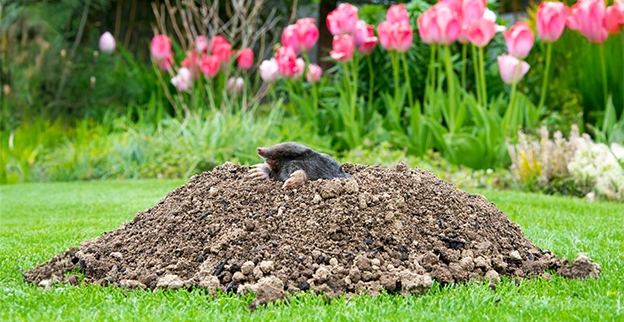Because the name “Mole” is very close to the name “Vole” confusion and miscommunication are very common. One way to distinguish the difference is by the diet of each animal. Voles “V”, are vegetarians (aka herbivores). The majority of their diet is made up of stems and leaves of grasses. Moles “M”, on the other hand, are meat-eaters; insectivores, to be precise. Moles feed on earthworms, insects, and grubs.
Moles are underground creatures, designed from their snout to their tail for life in the soil. They have tiny beady eyes and their ears are not visible. Large front paddle-like feet feature big claws perfect for digging their way through your lawn in search of earthworms, beetle grubs, ants, and other soil-dwelling insects. Their primary food source is the ever-present earthworm. Many people believe that having a mole problem means they also have a grub worm problem. However, this is an old wives tale. Yes, moles will eat grub worms and other soil-dwelling insects that they come across. But moles live mostly on earthworms. So the myth that you can control moles by controlling grubs in your lawn is simply not true. Moles will follow their food supply. Meaning that surface mole tunnels are seen more frequently during the spring and fall when the ground is moist, and earthworms move closer to the surface. Likewise, when soil becomes dry or frozen and earthworms move deeper into the ground, so do moles.
Identifying Mole Damage
Common signs that you're dealing with moles are volcano-like mounds of soil, raised soil ridges (about 1 inch high by 4 inches wide), and soft areas in your lawn that collapse when you walk on them. There is nothing more frustrating to a homeowner who works hard to keep a beautiful lawn, than seeing molehills and runways popping throughout their lawn. Moles are capable of extending surface runways about 100 feet per day causing damage to erupt at an alarming rate. Surface runs may be used daily or revisited at irregular intervals. A Mole's surface runways connect with deep runways, that are between 3 and 12 inches below the surface. These deep runways are usually the mole's main runways and allow them to travel to and from their surface runways or their nest easily. They deposit soil excavated from their deep tunnels on the surface through short vertical tunnels, creating volcano-like mounds.
Knowledgeable Staff
Our experienced and knowledgeable staff can answer any of your lawn care questions and provide you with helpful tips; so that together we can make your lawn look its best.



